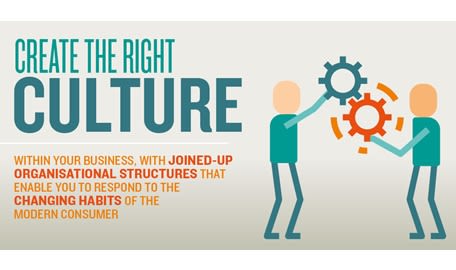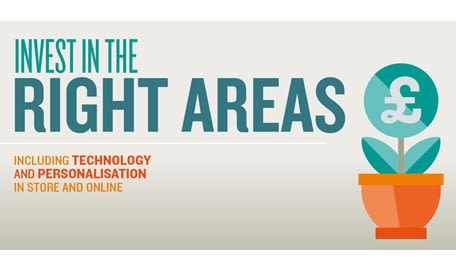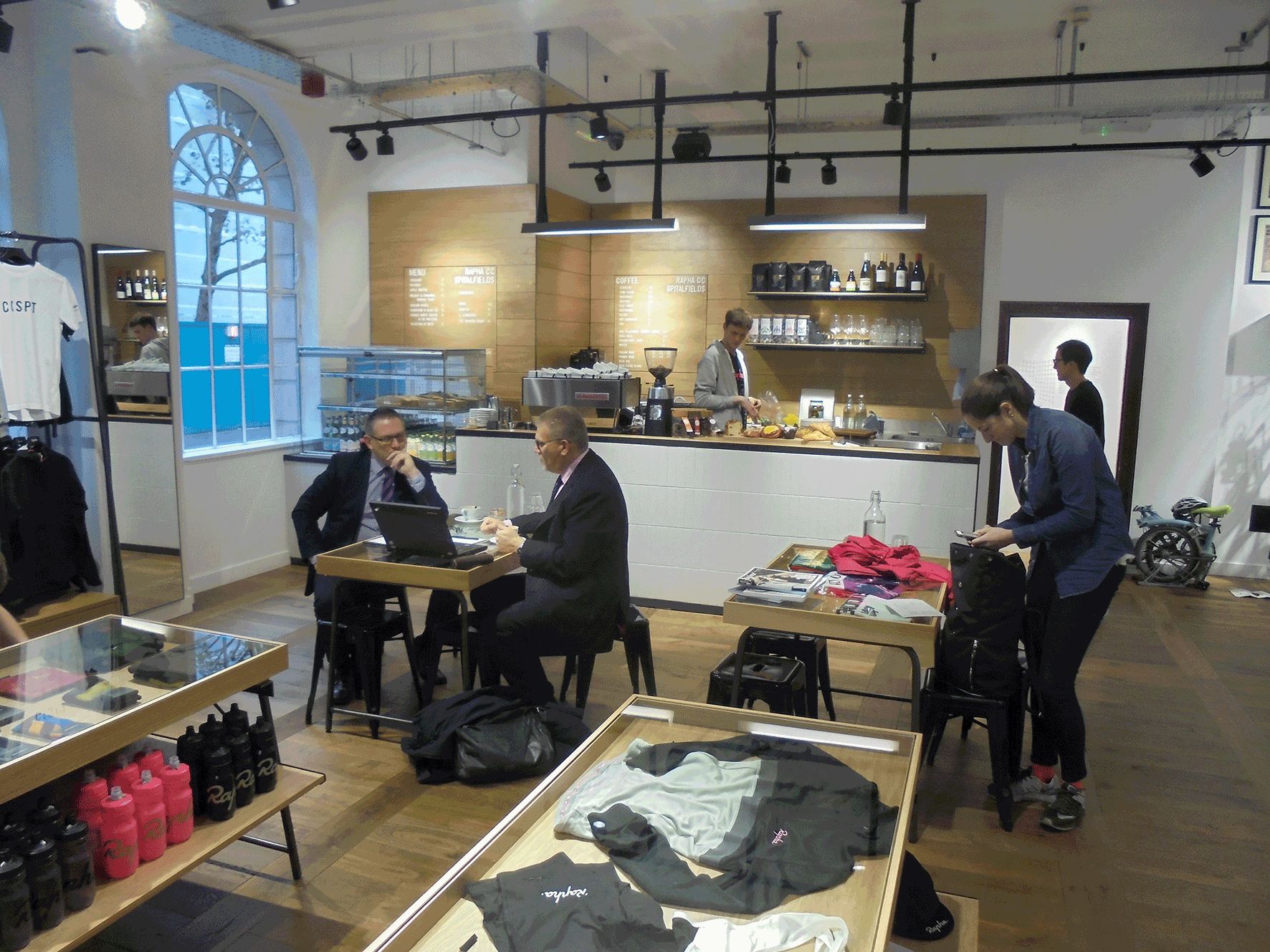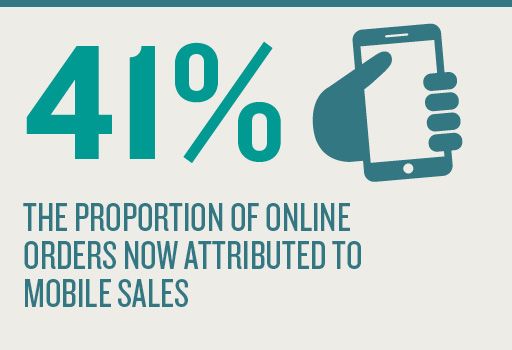Unified retail
A five-step guide to future-proofing your business

The ultimate goal for any retail business should be to satisfy its customer.
This ethos is not a new one and has guided retailers for centuries. However, what has arisen in this complex age of multiple retail channels and platforms is an acceptance that the consumer is in control and retailers that build their businesses around how, where and when their customers want to shop will reap the most rewards.
Unified retail may sound like an industry buzz phrase but experts believe it represents the inevitable next step
This new way of thinking can be best described as the unified retail approach.
Unified retail may sound like an industry buzz phrase but experts believe it represents the inevitable next step. Retailers need to transition from a channel mentality to one where the ultimate goal is to provide a customer-centric experience based on the shopping behaviour of the modern consumer.
Customer-centricity
“Omnichannel was about enabling your customer to transact with you on any of your channels and enabling the customer to move easily from one channel to another,” explains Rick Hobbs, chief technology officer at Salmon.
“Unified retail is taking this several steps further by breaking down the concept of different channels and looking at the retail experience as a holistic offering to your customers, no matter what touchpoints you have.”
Hobbs notes that, while omnichannel was largely about the technical integration of the different channels at the back end, the consumer would still have a relatively contrasting experience between different touchpoints at the front end.
The ethos behind a unified retail approach is to create a shopping experience entirely on the customer’s own terms rather than those imposed by the retailer.
“Unified retail breaks down the concept of different channels and looking at the retail experience as a holistic offering to your customers”
OC&C partner Michael Jary notes that the top 10 fastest growing retailers in the world last year – based on OC&C’s analysis of their price–earnings ratio – were primarily single-channel retailers.
“Some retailers should be in multiple channels, others are better off sticking to a few or even one. But to assume that widening channels in itself is the route to success is to fly in the face of evidence,” says Jary.
“For many retailers that has resulted in huge investment which has been neither cost-effective nor necessary.”
Discerning investment
Unified retail is not about ticking boxes. It is about retailers being more discerning about where they invest.
“They need to understand the relevance of each channel in helping the customer fulfil their journey and focus only on that,” says Jary.
“Typically this will still mean multiple channels, but it’s about linking to what customers really need rather than feeling obliged to offer everything.”
Trevor Hardy, chief executive of trends forecaster The Future Laboratory, points out that the browsing, learning, shopping and buying journey is a complex one that requires different inputs and channels at each stage.
Ultimately, he says, “a retailer that can bring out the strengths of each channel to optimise the consumer experience at each need state will be the one that wins the battle for hearts, minds and wallets”.
Retail Week has put together a five-step guide, in partnership with Salesforce, on how to begin the journey to unified retail. This digital guide will tell you how to:
- Create the right culture within your business, with joined-up organisational structures that enable you to respond to the changing habits of the modern consumer.
- Introduce new KPIs, step away from the channel mentality and understand how those channels combine to create a complete customer experience.
- Invest in the right areas including technology and personalisation in store and online.
- Leverage your assets by making the most of physical store space and further engaging consumers.
- Collaborate with partners that excel in areas where your business does not.
Create the right culture

Change needs to come from within a business if it stands a chance of keeping up with the modern consumer’s changing shopping habits.
For a retailer to be truly customer-centric, the entire organisation has to be structured to support this ideology. In practice, this means having much more integrated and joined-up organisational structures that enable businesses to respond to the changing consumer and technological landscape with speed and agility.
“Currently retailers work very much in silos,” explains Martin Newman, founder and chairman of retail consultancy Practicology.
Newman notes that the ecommerce team is often separate to the store team, which can mean there are discrete merchandising, content, customer service and marketing teams.
“Often the content is inconsistent across channels, as is the product mix. Therefore the customer doesn’t always get the right product in the right channel at the right time, nor the right marketing message or incentive”
“Take the latter,” he continues. “Digital marketing, which delivers the performance-based customer acquisition activity, is separate to the brand marketing team that drives store and brand-based marketing.
“Often the content is inconsistent across channels, as is the product mix. Therefore the customer doesn’t always get the right product in the right channel at the right time, nor the right marketing message or incentive.”

Cultural shift
The transition to a truly unified retail model will require a massive cultural shift within organisations, according to Alex Hamilton, head of insight at Isobar.
It will also put added onus on retailers to recruit experienced people to new and evolving roles, since, as Hamilton points out, “currently, most retailers do not have the right talent within their businesses to offer a unified experience to customers”.
Shop Direct is one example of a retailer that has aligned its recruitment strategy to its ambition to offer a unified customer experience. In late 2016 it hired Sainsbury’s head of technology Jon Rudoe to fill the newly created role of retail and technology director, charged with bringing the two teams even closer together.
Then chief executive Alex Baldock said Rudoe’s appointment marked a “pivotal point” in Shop Direct’s transformation by allowing the business “to respond more quickly to our customers’ rapidly changing needs, and to be faster to market in identifying and implementing new tech-focused opportunities”.
Shop Direct was also an early convert to the idea of appointing a customer director and in 2013 it appointed Dene Jones to the role – a position currently held by Sasha Berson.
Since leaving Shop Direct in April to take the helm at Dixons Carphone, one of Baldock’s first decisions was to hire Antreas Athanassopoulos as chief customer officer in a new role that will straddle complementary functions such as services, marketing and IT.
“Another structural addition will be the person charged with thinking about the future consumer – and how the business, products, services, experiences and technology will have to begin to change now to adapt to the needs of tomorrow”
Baldock also wasted no time in scrapping the retailer’s existing separate UK & Ireland and group executive teams, replacing them with one new, leaner leadership team – the group executive committee – designed to get rid of “unhelpful silos”. Baldock says the new structure aims to give the customer “a louder voice”.
According to Hardy, a new customer-centric role may evolve: “As the chief customer officer will be consumed with thinking about today’s customer, another structural addition will be the person charged with thinking about the future consumer – and how the business, products, services, experiences and technology will have to begin to change now to adapt to the needs of tomorrow.”
A different approach
Of course, not every business feels it needs a chief customer officer. Some would rather not put customer needs into the hands of one person, but would prefer to empower the whole organisation to take collective ownership.
Matthew Moulding, founder and chief executive of The Hut Group, which does not have a chief customer officer, says the business was borne out of a desire to put the customer first. “We’ve grown very rapidly as a business over the past 14 years, but that central focus on the customer is unchanged,” he says.
Through a dedicated team of data scientists analysing customer data at every touchpoint, the business seeks to understand what the customer wants at every stage and adapt to meet those needs.
Moulding believes culture is key to The Hut Group’s success. EBITDA was up 38% to £69m, in the year to December 31, 2017, when sales soared 47% to £736m. “We have an incredibly diverse pool of ambitious talent; our unique high performance and meritocratic culture encourages innovation and career growth at exceptional speed,” he says.
Despite its phenomenal rate of growth, boosted by strategic acquisitions such as Myprotein.com and Lookfantastic, Moulding says The Hut Group has worked hard to keep a nimble, entrepreneurial spirit.
“When some businesses grow larger, the dynamism can sometimes get lost in processes and bureaucracy – we don’t work like that at THG, and we make sure our number one focus is always the customer.”
Introduce new KPIs

Unified retail will require retailers to rethink many facets of traditional business models, including key performance indicators (KPIs).
As Hamilton says: “A lot of retailers are more in the mindset of ‘what are our sales’ and ‘how can we make incremental gains’, they are not thinking about the bigger picture.”
“A failure to understand changing customer behaviour across channels and touchpoints could mean retailers make ill-informed decisions about store closures or how to invest in their websites and online presence“
Many retailers still have a channel mentality and they risk getting hung up on the cost to serve in different channels rather than on understanding how those channels contribute towards a complete customer experience.
Writing in Retail Week in January, Newman noted: “Most retailers still have a P&L for online that only measures incremental sales and margin. This provides a flawed view. After all, their own websites are their biggest marketing campaign and in many cases drive more than 60% of footfall to stores.”
Newman said a failure to understand changing customer behaviour across channels and touchpoints could mean retailers make ill-informed decisions about store closures or how to invest in their websites and online presence.
He added that, currently, operational and commercial KPIs such as conversion rates, average order values and footfall tend to be tracked by retailers. “While we need to know what these are, they are the outputs not the inputs,” he explained. “We need to know NPS [net promoter score], ratings and reviews, sentiment analysis, retention levels, lifetime value. These drive the outputs.”

Rethinking the metrics
The latest thinking suggests retailers should monitor like-for-like sales but at a catchment level that incorporates online sales in that region, not just store sales. Other emerging KPIs include the value of a store based on how much data it collects rather than the revenue it generates, as well as website speed and functionality.
Asos uses a number of metrics including site visits, duration of visits, active customers, increased average order frequency and average basket value to assess its performance.
Online mattress retailer Eve Sleep founder Jas Bagniewski has said that his key measure is the percentage of revenue that goes on marketing spend. As this percentage gets smaller, due to increased brand awareness and rising sales, the model becomes profitable, he says.
Indeed brand awareness is another indicator increasingly being monitored by retailers, including AO.com which measures both prompted and unprompted brand awareness.
Measuring loyalty
Once retailers have attracted new customers the next challenge is to hold on to them. Amid fierce competition for shopper spend, the ability to create loyal shoppers is a key indicator of the long-term sustainability of the business model.
Sam Fuller, managing director of M&A advisor GCA Altium, recently told Retail Week: “If you go to the right investor they don’t care about revenue growth or profit growth, they just want to see customer acquisition and loyalty trends.”
The implications are clear: under a unified retail model, retailers should stop obsessing about conversion rates and which channels are driving sales, and focus their energy on trying to understand those indicators that evidence the value of the customer over their lifetime, not a single visit to the website or store.
Invest in the right areas

‘Tech for tech’s sake’ is a well-worn phrase in retail but for good reason. Retailers need focus and should invest in areas that make sense for their business and their customer.
OC&C’s Jary offers two examples that show how retailers at two ends of the spectrum choose to invest and engage with their customers.
“Burberry has placed a clear stake in the ground to become the brand of choice for one core customer group – luxury millennials. So investment is targeted on the channels that carry the most influence: social media.”
Jary adds: “Primark has great content and advice online, but customers head to a store to purchase. The stores are receiving the investment and are becoming bigger, more exciting and better experiences.”
Focusing on tech
While retailers will have differing priorities, what most agree on is there has to be some degree of investment in tech.
If the aim is customer-centricity, unified retailers need a platform that gives them a 360-degree view of the customer that can inform and align every interaction.
One example is Adidas, which is using a number of Salesforce’s clouds to deliver a unified offer to consumers. The marketing cloud gives the sportswear brand the ability to provide one-to-one personalised journeys by connecting with the customer across every channel including mobile and social.
Meanwhile, a new data management platform allows Adidas to capture online web behaviours and marry them with CRM data so it can deliver personalised ads to the consumer at scale.
Newman stresses that it’s vitally important software gives retailers the opportunity to deliver highly personalised and relevant communications, content and offers to customers. “You will need to be able to personalise the customer’s experience more effectively than almost anyone can today,” he says.
“You will need to be able to personalise the customer’s experience more effectively than almost anyone can today”
Personalisation in store
For retailers with a predominantly bricks-and-mortar business, having a single customer view can help deliver a more personalised service in store.
Bed retailer Dreams has recently introduced in-store technology that allows staff to see what the customer has browsed online and help them with the next stage of the journey.
Above all, systems to support a unified model must give retailers the agility to respond to new drivers of shopper behaviour. “It is about responding rapidly to market or social trends,” explains Hobbs.
“For example, noticing a particular meme, and using that as the basis for a campaign to drive customers towards an exclusive event in store for a new range of products. You can then extend this further by offering next-day delivery and a follow-up reward for talking about it on social media.”

It’s not all about systems though. Despite talk of the store being dead, increasingly the most unexpected retailers are investing in physical space.
Amazon is rumoured to be looking to open further stores following the launch of Amazon Go in Seattle and its purchase of Whole Foods, while Chinese online retail giants Alibaba and JD.com have pledged to open thousands of stores in their native China, using data analytics services to better target local catchments.
Online menswear retailer Bonobos has physical ‘guideshops’ which carry no inventory whatsoever. A guide walks customers through the Bonobos range before taking orders online and arranging delivery to the customer’s home.
Rapha rides ahead
Rapha epitomises the growing trend for retailers to immerse themselves in the communities they serve and become a destination for fans of their brand.
Founded by Simon Mottram in London in 2004, Rapha spent its first half decade as an online retailer developing and selling classic cycling jerseys. That changed in 2010 when it began opening ‘clubhouses’ where customers, and cycling fans more generally, can experience the brand in person while drinking coffee, watching races and browsing products.
There are now more than 30 clubhouses located around the world hosting regular events and organising ride outs for the local chapter of the Rapha Cycling Club, which was established in 2015 and currently has more than 7,000 members.

Cycling retailer Rapha has opened 30 ‘clubhouses’ around the world
Cycling retailer Rapha has opened 30 ‘clubhouses’ around the world
Leverage your assets

A change in mindset, processes and systems requires investment. However, most retailers will understandably want to sweat their existing assets as much as possible.
Take stores, which, rather than being seen as a burden on retailers in the context of the growth of online sales, should be viewed for their potential to engage customers on a one-to-one basis – both through store employees and technology via their mobile devices.

Data from Salesforce for the first quarter of 2018 shows that in the context of a 10% year-on-year increase in online order growth, mobile orders grew 35% compared with just 1% for computers and 0% for tablets. Mobile now accounts for 41% of online orders compared with 50% for computers and the gap is closing all the time.
Smart use of mobile devices by retailers is key to creating a unified experience. Hobbs explains that mobile devices enable customers to receive relevant and timely communications, deals and promotions, and respond to these in the moment, providing they are simple. Such communications are increasingly location-based and Newman believes that in the future more and more shoppers will interact with marketing and promotional offers from retailers on their phones through proximity-led marketing initiatives.
In this environment mobile clienteling solutions are fast becoming a must for traditional bricks-and-mortar retailers.

David Nicholls, retail customer solutions architect at Fujitsu UK and Ireland, says: “Store colleagues will increasingly act as advisors and have access to both customer and product insight in the aisle through mobile devices, enabling them to bridge customer online to in-store journeys, engage them in a personalised and relevant way, and drive efficiency and productivity.
“Unified retail provides retailers with another weapon in their armoury against the online retail juggernaut. It brings together the choice and availability of online retailing with the discovery, service and immediacy valued by shoppers in store.”
The store is a stage
Hobbs, meanwhile, says the use of augmented reality (AR) technologies on customers’ mobiles can enable retailers to use the store as a stage to bring their products to life, for example by showing how an item of clothing would fit a person. All of this adds to the feeling that the customer is receiving an outstanding and personalised service.
Stores are often retailers’ most costly asset and some brands are increasingly looking to make the most of their physical space by subletting – this spreads the burden of rates and rents while creating more reasons for consumers to shop with them by broadening their offer (more on this in chapter five).
Traditional high street retailers are also evolving their logistics networks to leverage their physical assets. Nicholls cites the example of Argos, which through its ‘hub and spoke’ model is using its larger stores as regional fulfilment centres to provide fast and efficient four-hour delivery slots to customers.
Collaborate

Once upon a time, the accepted wisdom when it came to the retailer–supplier relationship was that the former was firmly in the driving seat.
But now retailers and suppliers are increasingly being seen as equals. If retailers are to thrive in the face of Amazon they must collaborate with partners that excel at the things they do not.
This new era of collaboration will form a key part of the unified retail model and require a shift in mindset where retailers view experts as equal partners as opposed to service providers.
In a recent blog post, Gartner research director Robert Hetu said unified retail will come to the fore when “retailers, suppliers, third-party services and customers can collaborate to build an effective ecosystem centred on delivering exceptional customer-centric experiences”.
If retailers are to thrive in the face of Amazon they must collaborate with partners that excel at the things they do not
In 2015 Gartner predicted that by 2018 more than half of ecommerce sites would integrate technologies from more than 15 vendors to deliver a digital customer experience. Implicit in this prediction is that, to take advantage of the opportunities offered by digital, retailers will need to work with a wide pool of partners to deliver an exceptional customer experience.
Convenience collaborations
Traditional retailers are partnering with tech disruptors to fulfil customer demands for greater convenience. The Co-op has partnered with Deliveroo to pilot home deliveries through five stores in the Greater Manchester area, close to its One Angel Square HQ, as the retailer seeks to boost its convenience credentials. This is particularly significant as it is the grocer’s first foray into online food deliveries.
The supply chain is a good example of where collaboration could reap huge benefits when it comes to cost but also in fulfilling customer expectations, and there are likely to be more alliances such as that between Clipper Logistics and John Lewis.
They formed a 50/50 joint venture in 2016 to provide click-and-collect services to other retailers, with Clipper operating the service and John Lewis providing retail expertise.
The Entertainer allows XPO, as its logistics provider, to use spare warehousing and transport capacity for its other clients with different trading patterns, spreading the costs across retailers.
B&Q, meanwhile, has previously loaned fleets and drivers to supermarkets and other retailers so it can capitalise on the peak Christmas trading period during its own off-peak season.

Brand hook-ups
Retailers are collaborating with other consumer brands too. Next has partnered with multichannel car retailer Rockar to turn excess space at its largest store into a car showroom.
The fashion retailer is transforming part of its shop in Manchester’s Arndale centre into a space big enough to feature several cars. The money it saves from ventures such as these will allow it to invest it areas that will move the dial when it comes to the customer experience.
There are other examples across retail, particularly among grocery giants Tesco and Sainsbury’s, both of which have sublet to brands including Timpson and Dixons Carphone.
The successful retailers will be those that realise they cannot go it alone and instead embrace the fact they are part of an ecosystem with the same goal – to better serve the customer.
Partner comment

Retail is not just about channels. It has always has been about providing the customer with a great range of products, at the right price, supported by a credible service proposition.
However, retailers are facing new challenges posed by shoppers who have never had so much choice and information at their fingertips.
As seen in this guide, there is a serious need for retailers to deliver on unified retail, offering a seamless experience that blends the best of offline and online shopping across each touchpoint with marketing, ecommerce and service.
According to our research, 75% of shoppers expect personalised experiences and 61% are prepared to exchange data in return for faster and better service. The gauntlet has been thrown.
Retailers need to offer flexibility to suit today’s demanding customer. A customer could decide to buy something in store one day and online the next – either way, factors including the experience, product range, customer service and loyalty scheme need to be as consistent and frictionless as possible across both channels.
Retailers have to be set up to cater for any eventuality just as their competitors will be.
Organising the right team to relentlessly focus on your customer is a crucial consideration. However, having the right technology in place to deliver the unified retail experience will ensure they have access to a single view of the customer across all functions of the business and can deliver a convenient and frictionless experience.
Savvy retailers are using AI to deliver a more predictive and personalised experience, drawing on insights from online and in-store shopper data to delight customers across all channels
There is no denying the customer experience can be enhanced by artificial intelligence (AI). Savvy retailers are using AI to deliver a more predictive and personalised experience, drawing on insights from online and in-store shopper data to delight customers across all channels.
Looking to the future, retailers can even start personalising prices based on a customer’s interaction and service history, as well as demand, product pricing history, competitor activity and inventory levels.
Aggregated data from our customers’ sites shows that of all visits, 7% interact with product recommendations driven by our Salesforce Einstein platform, which removes the complexity of AI, enabling any company to deliver smarter, personalised and more predictive customer experiences.
That figure may seem small at first, but it is driving significant revenue, accounting for nearly a quarter of all orders. The impact is substantial, even in these early days.
As shoppers share their data, they also share an expectation and the onus falls upon the retailer to deliver on and exceed these expectations.

Jamie Merrick, director of strategic solutions, retail, at Salesforce
Jamie Merrick, director of strategic solutions, retail, at Salesforce
Unified retail
A five-step guide to future-proofing
your business
Written by Nick Hughes
Produced by The Creativity Club and Emily Kearns
In partnership with Salesforce

